ObjectDataSource&&Gridview
ASP.NET 1.x 中DataGrid的功能在ASP.NET 2.0中得到了增强。DataGrid增强的功能在2.0中分散到了GridView、DetailsView 和FormView 三个控件中。今天讨论一下GridView与DetailsView如何联合使用。
GridView和DetailsView的用法与1.x中有很大的不同,主要是2.0新增了4个DataSource控件。其中有3个直接或间接继承自System.Web.UI.DataSourceControl 另一个(SiteMapDataSource)继承自System.Web.UI.HierarchicalDataSourceControl。在实际应用中,用的较多的是ObjectDataSource。ObjectDataSource控件支持Web开发的三层架构,把表示层和数据层真正分开了。
ObjectDataSource允许指定一个类给它的TypeName属性。同时指定这个类的一个公共方法给它的SelectMethod属性。这可以是一个中间层的类,在这个类中可以调用数据层的方法也可以与数据层完全无关。与ObjectDataSource相连的GridView或DetailsView则只负责显示,而与数据逻辑无关。
要在GridView中显示数据只要把一个ObjectDataSource的ID赋给GridView的DataSourceID属性(实际上GridView中绑定的数据源只需要实现IEnumerable 或 ItypedList接口即可)。
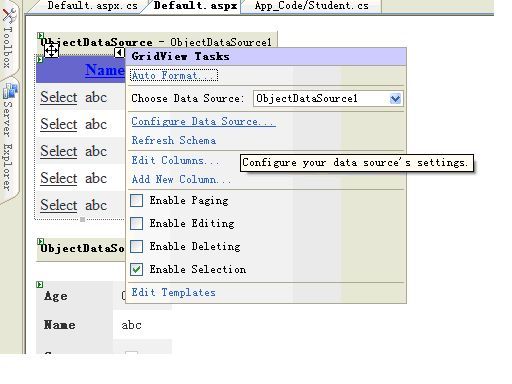
在GridView的Smart Tag中有Choose Data Source的选项,可以选取页面中已存在的DataSource。选定DataSource后可以点击Configure Data Source,会出现下面的界面
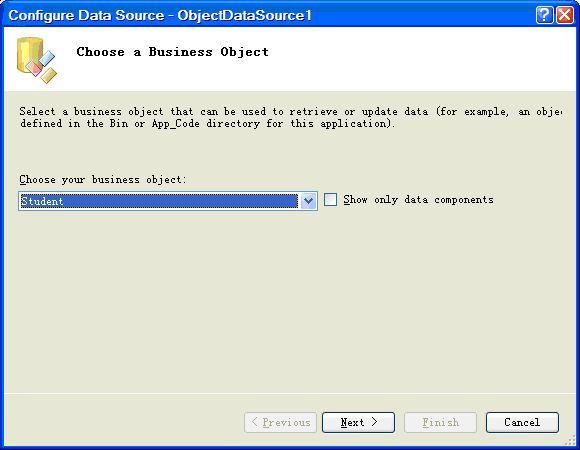 在其中可以选择一个类,这个类的类名将会作为ObjectDataSource的TypeName属性。然后Next下去…
在其中可以选择一个类,这个类的类名将会作为ObjectDataSource的TypeName属性。然后Next下去…
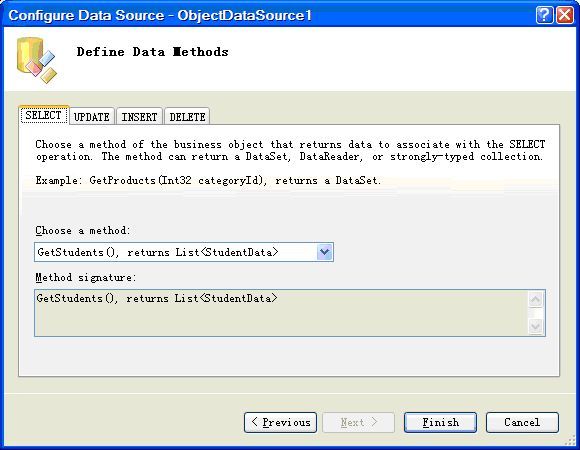 在这可以选择select、update、insert和delete分别对应的方法。但可以不选。一个ObjectDataSource的select方法是必须要有的,如果没有在这个界面中选择的话,可以在Page_Load方法中根据需要指定,例如(这个小示例与下面的例子无关):
在这可以选择select、update、insert和delete分别对应的方法。但可以不选。一个ObjectDataSource的select方法是必须要有的,如果没有在这个界面中选择的话,可以在Page_Load方法中根据需要指定,例如(这个小示例与下面的例子无关):
1
 void
Page_Load(
object
sender, EventArgs e)
void
Page_Load(
object
sender, EventArgs e)
2

 {
{
3 if (!Page.IsPostBack)
if (!Page.IsPostBack)
4

 {
{
5 if (Page.User.IsInRole("Administrator"))
if (Page.User.IsInRole("Administrator"))
6

 {
{
7 ObjectDataSource1.SortParameterName = "sortParameter";
ObjectDataSource1.SortParameterName = "sortParameter";
8 ObjectDataSource1.SelectMethod = "GetStudents";
ObjectDataSource1.SelectMethod = "GetStudents";
9 }
}
10 else
else
11

 {
{
12 ObjectDataSource1.SelectParameters.Add(new Parameter("Name", TypeCode.Int32, Page.User.Identity.Name));
ObjectDataSource1.SelectParameters.Add(new Parameter("Name", TypeCode.Int32, Page.User.Identity.Name));
13 ObjectDataSource1.SortParameterName = "sortParameter";
ObjectDataSource1.SortParameterName = "sortParameter";
14 ObjectDataSource1.SelectMethod = "SelectStudent";
ObjectDataSource1.SelectMethod = "SelectStudent";
15 }
}
16 }
}
17 }
}
 void
Page_Load(
object
sender, EventArgs e)
void
Page_Load(
object
sender, EventArgs e)2


 {
{3
 if (!Page.IsPostBack)
if (!Page.IsPostBack)4


 {
{5
 if (Page.User.IsInRole("Administrator"))
if (Page.User.IsInRole("Administrator"))6


 {
{7
 ObjectDataSource1.SortParameterName = "sortParameter";
ObjectDataSource1.SortParameterName = "sortParameter";8
 ObjectDataSource1.SelectMethod = "GetStudents";
ObjectDataSource1.SelectMethod = "GetStudents";9
 }
}10
 else
else11


 {
{12
 ObjectDataSource1.SelectParameters.Add(new Parameter("Name", TypeCode.Int32, Page.User.Identity.Name));
ObjectDataSource1.SelectParameters.Add(new Parameter("Name", TypeCode.Int32, Page.User.Identity.Name));13
 ObjectDataSource1.SortParameterName = "sortParameter";
ObjectDataSource1.SortParameterName = "sortParameter";14
 ObjectDataSource1.SelectMethod = "SelectStudent";
ObjectDataSource1.SelectMethod = "SelectStudent";15
 }
}16
 }
}17
 }
}
对于GridView的数据显示,一个常见的问题是:它根据什么生成行,又根据什么生成列呢?GridView需要的数据源只需实现IEnumerable 或 ItypedList接口。所以ObjectDataSource的select方法的返回值也必然要遵守几个条件:实现IEnumerable 或 ItypedList接口或直接是DataSet。如果返回值是DataSet,GridView会根据DataSet中的第一个Table生成行和列。否则,将枚举每一个返回值作为一行,并根据返回值的类型应用反射技术找出它的public属性作为列(前提是AltoGenerateColumn属性设为true)。例如:select方法返回类型是List<StrudentData>
StudentData类型有Name, Age, ID, Sex等属性,那么GridView就会将返回的每一个StudentData作为一行,并生成相应的Name, Age, ID, Sex列。
DetailsView如果想要显示GridView当中选定行的详细信息,则需要新建一个ObjectDataSource,这个ObjectDataSource的TypeName一般与第一个ObjectDataSource的TypeName相同,但是它的select方法应该与第一个ObjectDataSource的不同。不同之处在于这个select方法应该接收一个参数(一般应该是返回类型的主键),用以确定显示哪个实例的具体信息。
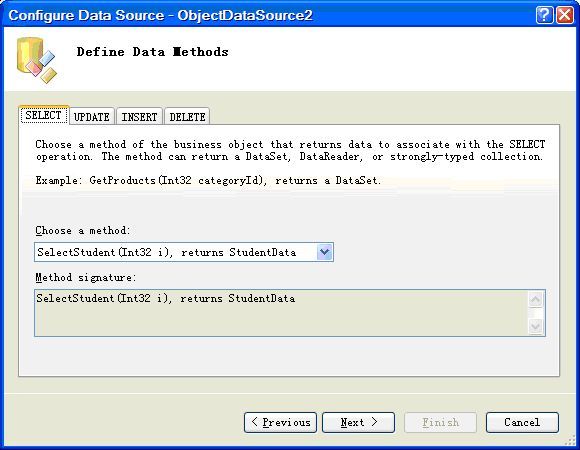
在接下来的Wizard中
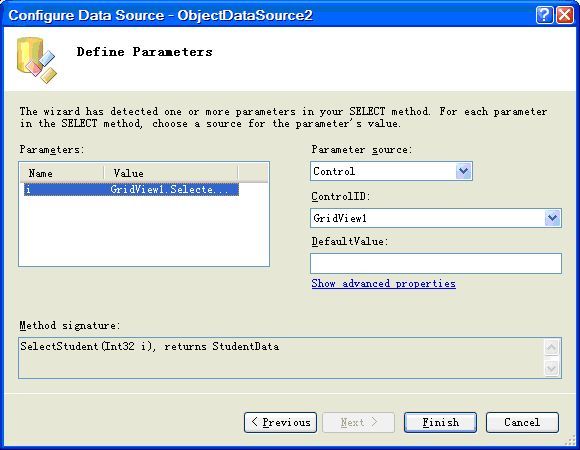 要选取这个参数的数据源。注意右边的Parameter source,这里选择的是Control,表示是从页面的控件中读取数据。这个选项中还有Cookie,Form,Session等,分别代表不同的数据源。选择Control后,下面变成了ControlID的选择,这里选择了GridView1,就是要与之相连的GridView。注意左边的Parameters框,i的Value变成了GridView1.SelectValue。但仅仅这样的话,i是得不到值的。这里必须提到DataKeyName属性,这个属性代表GridView中数据的主键, 在这里GridView1的DataKeyName属性不能为空。也就是说,GridView的SelectValue属性实际上是选中行的名为DataKeyName的属性的值。即:如果GridView1的DataKeyName属性为”ID”,它所显示的数据列有一列为“ID”,则给i赋的值就是ID列的值。
要选取这个参数的数据源。注意右边的Parameter source,这里选择的是Control,表示是从页面的控件中读取数据。这个选项中还有Cookie,Form,Session等,分别代表不同的数据源。选择Control后,下面变成了ControlID的选择,这里选择了GridView1,就是要与之相连的GridView。注意左边的Parameters框,i的Value变成了GridView1.SelectValue。但仅仅这样的话,i是得不到值的。这里必须提到DataKeyName属性,这个属性代表GridView中数据的主键, 在这里GridView1的DataKeyName属性不能为空。也就是说,GridView的SelectValue属性实际上是选中行的名为DataKeyName的属性的值。即:如果GridView1的DataKeyName属性为”ID”,它所显示的数据列有一列为“ID”,则给i赋的值就是ID列的值。
在DetailsView中如果主键列不显示,也必须把主键列的列名赋值给DataKeyName属性(多个主键可以用逗号分开)。因为ViewState中只存放所显示列的值和在DataKeyName中指定的列的值。如果不赋值给DataKeyName的话,在DetailsView中使用Update、Delete方法的时候,主键列从ViewState中读取不到值,将会用默认值代替,这样就得不到想要的结果。
最后,介绍一下ObjectDataSource的DataObjectTypeName属性。我们在Update和Insert的时候往往需要多个参数代表对象的不同属性。这种做法首先容易出错,其次也不利于数据的封装。于是ObjectDataSource添加了一个DataObjectTypeName属性,这个属性确定了一个类,这个类可以封装要被修改或插入的值的全部属性值。在确定了这个属性后,在Update和Insert的函数中就可以用DataObjectTypeName属性定义的那个类作为参数类型。DataObjectTypeName的这种用法在下面的例子中可以看到。在调用在Update和Insert的时候,ASP.NET会自动实例化一个DataObjectTypeName属性定义的类型,并给它赋值,然后传给调用的函数。
做为DataObjectTypeName属性的类主要有以下三点要求:
1. 这个类必须有一个缺省的构造函数(就是0参数的构造函数)
2. 这个类的公有属性名必须和GridView或DetailsView所绑定的类的公有属性名相同
3. 这些公有属性必须get和set两种方法都具备。
经过上面的配置,GridView和DetailsView就可以配合使用了。下面是一个例子:
页面文件:

 <%
<%
 @ Page Language="C#" AutoEventWireup="true" CodeFile="Default.aspx.cs" Inherits="_Default"
%>
@ Page Language="C#" AutoEventWireup="true" CodeFile="Default.aspx.cs" Inherits="_Default"
%>

 <!
DOCTYPE html PUBLIC "-//W3C//DTD XHTML 1.1//EN" "http://www.w3.org/TR/xhtml11/DTD/xhtml11.dtd"
>
<!
DOCTYPE html PUBLIC "-//W3C//DTD XHTML 1.1//EN" "http://www.w3.org/TR/xhtml11/DTD/xhtml11.dtd"
>
 <
html
xmlns
="http://www.w3.org/1999/xhtml"
>
<
html
xmlns
="http://www.w3.org/1999/xhtml"
>
 <
head
runat
="server"
>
<
head
runat
="server"
>
 <
title
>
Untitled Page
</
title
>
<
title
>
Untitled Page
</
title
>
 </
head
>
</
head
>
 <
body
>
<
body
>
 <
form
id
="form1"
runat
="server"
>
<
form
id
="form1"
runat
="server"
>
 <
asp:ObjectDataSource
ID
="ObjectDataSource1"
runat
="server"
InsertMethod
="InsertStudent"
SelectMethod
="GetStudents"
TypeName
="Student"
UpdateMethod
="UpdateStudent"
OldValuesParameterFormatString
="Original_{0}"
DataObjectTypeName
="StudentData"
DeleteMethod
="DeleteStudent"
>
<
asp:ObjectDataSource
ID
="ObjectDataSource1"
runat
="server"
InsertMethod
="InsertStudent"
SelectMethod
="GetStudents"
TypeName
="Student"
UpdateMethod
="UpdateStudent"
OldValuesParameterFormatString
="Original_{0}"
DataObjectTypeName
="StudentData"
DeleteMethod
="DeleteStudent"
>
 </
asp:ObjectDataSource
>
</
asp:ObjectDataSource
>
 <
div
>
<
div
>
 <
asp:GridView
ID
="GridView1"
runat
="server"
AllowSorting
="True"
CellPadding
="4"
DataSourceID
="ObjectDataSource1"
ForeColor
="#333333"
GridLines
="None"
DataKeyNames
="ID"
AutoGenerateColumns
="False"
>
<
asp:GridView
ID
="GridView1"
runat
="server"
AllowSorting
="True"
CellPadding
="4"
DataSourceID
="ObjectDataSource1"
ForeColor
="#333333"
GridLines
="None"
DataKeyNames
="ID"
AutoGenerateColumns
="False"
>
 <
FooterStyle
BackColor
="#507CD1"
Font-Bold
="True"
ForeColor
="White"
/>
<
FooterStyle
BackColor
="#507CD1"
Font-Bold
="True"
ForeColor
="White"
/>
 <
RowStyle
BackColor
="#EFF3FB"
/>
<
RowStyle
BackColor
="#EFF3FB"
/>
 <
Columns
>
<
Columns
>
 <
asp:CommandField
ShowSelectButton
="True"
/>
<
asp:CommandField
ShowSelectButton
="True"
/>
 <
asp:BoundField
DataField
="Name"
HeaderText
="Name"
SortExpression
="Name"
/>
<
asp:BoundField
DataField
="Name"
HeaderText
="Name"
SortExpression
="Name"
/>
 </
Columns
>
</
Columns
>
 <
PagerStyle
BackColor
="#2461BF"
ForeColor
="White"
HorizontalAlign
="Center"
/>
<
PagerStyle
BackColor
="#2461BF"
ForeColor
="White"
HorizontalAlign
="Center"
/>
 <
SelectedRowStyle
BackColor
="#D1DDF1"
Font-Bold
="True"
ForeColor
="#333333"
/>
<
SelectedRowStyle
BackColor
="#D1DDF1"
Font-Bold
="True"
ForeColor
="#333333"
/>
 <
HeaderStyle
BackColor
="#507CD1"
Font-Bold
="True"
ForeColor
="White"
/>
<
HeaderStyle
BackColor
="#507CD1"
Font-Bold
="True"
ForeColor
="White"
/>
 <
EditRowStyle
BackColor
="#2461BF"
/>
<
EditRowStyle
BackColor
="#2461BF"
/>
 <
AlternatingRowStyle
BackColor
="White"
/>
<
AlternatingRowStyle
BackColor
="White"
/>
 </
asp:GridView
>
</
asp:GridView
>

 <
asp:ObjectDataSource
ID
="ObjectDataSource2"
runat
="server"
DataObjectTypeName
="StudentData"
<
asp:ObjectDataSource
ID
="ObjectDataSource2"
runat
="server"
DataObjectTypeName
="StudentData"
 DeleteMethod
="DeleteStudent"
InsertMethod
="InsertStudent"
SelectMethod
="SelectStudent"
DeleteMethod
="DeleteStudent"
InsertMethod
="InsertStudent"
SelectMethod
="SelectStudent"
 TypeName
="Student"
UpdateMethod
="UpdateStudent"
>
TypeName
="Student"
UpdateMethod
="UpdateStudent"
>
 <
SelectParameters
>
<
SelectParameters
>
 <
asp:ControlParameter
ControlID
="GridView1"
Name
="i"
PropertyName
="SelectedValue"
<
asp:ControlParameter
ControlID
="GridView1"
Name
="i"
PropertyName
="SelectedValue"
 Type
="Int32"
/>
Type
="Int32"
/>
 </
SelectParameters
>
</
SelectParameters
>
 </
asp:ObjectDataSource
>
</
asp:ObjectDataSource
>

 </
div
>
</
div
>
 <
asp:DetailsView
ID
="DetailsView1"
runat
="server"
Height
="50px"
Width
="125px"
CellPadding
="8"
DataSourceID
="ObjectDataSource2"
ForeColor
="#333333"
GridLines
="None"
AutoGenerateRows
="False"
Font-Names
="宋体"
Font-Overline
="False"
Font-Size
="10pt"
Font-Strikeout
="False"
Font-Underline
="False"
DataKeyNames
="ID"
>
<
asp:DetailsView
ID
="DetailsView1"
runat
="server"
Height
="50px"
Width
="125px"
CellPadding
="8"
DataSourceID
="ObjectDataSource2"
ForeColor
="#333333"
GridLines
="None"
AutoGenerateRows
="False"
Font-Names
="宋体"
Font-Overline
="False"
Font-Size
="10pt"
Font-Strikeout
="False"
Font-Underline
="False"
DataKeyNames
="ID"
>
 <
FooterStyle
BackColor
="#507CD1"
Font-Bold
="True"
ForeColor
="White"
/>
<
FooterStyle
BackColor
="#507CD1"
Font-Bold
="True"
ForeColor
="White"
/>
 <
CommandRowStyle
BackColor
="#D1DDF1"
Font-Bold
="True"
/>
<
CommandRowStyle
BackColor
="#D1DDF1"
Font-Bold
="True"
/>
 <
RowStyle
BackColor
="#EFF3FB"
/>
<
RowStyle
BackColor
="#EFF3FB"
/>
 <
FieldHeaderStyle
BackColor
="#DEE8F5"
Font-Bold
="True"
/>
<
FieldHeaderStyle
BackColor
="#DEE8F5"
Font-Bold
="True"
/>
 <
PagerStyle
BackColor
="#2461BF"
ForeColor
="White"
HorizontalAlign
="Left"
/>
<
PagerStyle
BackColor
="#2461BF"
ForeColor
="White"
HorizontalAlign
="Left"
/>
 <
Fields
>
<
Fields
>
 <
asp:BoundField
DataField
="Age"
HeaderText
="Age"
SortExpression
="Age"
/>
<
asp:BoundField
DataField
="Age"
HeaderText
="Age"
SortExpression
="Age"
/>
 <
asp:BoundField
DataField
="Name"
HeaderText
="Name"
SortExpression
="Name"
/>
<
asp:BoundField
DataField
="Name"
HeaderText
="Name"
SortExpression
="Name"
/>
 <
asp:CheckBoxField
DataField
="Sex"
HeaderText
="Sex"
SortExpression
="Sex"
/>
<
asp:CheckBoxField
DataField
="Sex"
HeaderText
="Sex"
SortExpression
="Sex"
/>
 <
asp:CommandField
ShowDeleteButton
="True"
ShowEditButton
="True"
ShowInsertButton
="True"
/>
<
asp:CommandField
ShowDeleteButton
="True"
ShowEditButton
="True"
ShowInsertButton
="True"
/>
 </
Fields
>
</
Fields
>
 <
HeaderStyle
BackColor
="#507CD1"
Font-Bold
="True"
ForeColor
="White"
/>
<
HeaderStyle
BackColor
="#507CD1"
Font-Bold
="True"
ForeColor
="White"
/>
 <
EditRowStyle
BackColor
="#2461BF"
/>
<
EditRowStyle
BackColor
="#2461BF"
/>
 <
AlternatingRowStyle
BackColor
="White"
/>
<
AlternatingRowStyle
BackColor
="White"
/>
 </
asp:DetailsView
>
</
asp:DetailsView
>
 </
form
>
</
form
>
 </
body
>
</
body
>
 </
html
>
</
html
>

Default.aspx.cs
 using
System;
using
System; using
System.Data;
using
System.Data; using
System.Configuration;
using
System.Configuration; using
System.Web;
using
System.Web; using
System.Web.Security;
using
System.Web.Security; using
System.Web.UI;
using
System.Web.UI; using
System.Web.UI.WebControls;
using
System.Web.UI.WebControls; using
System.Web.UI.WebControls.WebParts;
using
System.Web.UI.WebControls.WebParts; using
System.Web.UI.HtmlControls;
using
System.Web.UI.HtmlControls;
 public
partial
class
_Default : System.Web.UI.Page
public
partial
class
_Default : System.Web.UI.Page 

 {
{ protected void Page_Load(object sender, EventArgs e)
protected void Page_Load(object sender, EventArgs e)

 {
{ DetailsView1.ItemCreated += delegate(object s, EventArgs ee)
DetailsView1.ItemCreated += delegate(object s, EventArgs ee)

 {
{ GridView1.DataBind();
GridView1.DataBind(); };
};
 DetailsView1.ItemDeleted += delegate(object s, DetailsViewDeletedEventArgs ee)
DetailsView1.ItemDeleted += delegate(object s, DetailsViewDeletedEventArgs ee)

 {
{ GridView1.DataBind();
GridView1.DataBind(); };
};
 DetailsView1.ItemUpdated += delegate(object s, DetailsViewUpdatedEventArgs ee)
DetailsView1.ItemUpdated += delegate(object s, DetailsViewUpdatedEventArgs ee)

 {
{ GridView1.DataBind();
GridView1.DataBind(); };
}; }
}
 }
}

 using
System;
using
System; using
System.Data;
using
System.Data; using
System.Configuration;
using
System.Configuration; using
System.Web;
using
System.Web; using
System.Collections.Generic;
using
System.Collections.Generic; using
System.Web.Security;
using
System.Web.Security; using
System.Web.UI;
using
System.Web.UI; using
System.Web.UI.WebControls;
using
System.Web.UI.WebControls; using
System.Web.UI.WebControls.WebParts;
using
System.Web.UI.WebControls.WebParts; using
System.Web.UI.HtmlControls;
using
System.Web.UI.HtmlControls;
 public
class
Student
public
class
Student

 {
{ static private List<StudentData> students;
static private List<StudentData> students;
 public Student()
public Student()

 {
{ if (students == null)
if (students == null)

 {
{ students = new List<StudentData>();
students = new List<StudentData>(); StudentData data = new StudentData("Chiewen Ly", 23, true);
StudentData data = new StudentData("Chiewen Ly", 23, true); students.Add(data);
students.Add(data);
 data = new StudentData("A~ Foo", 24, false);
data = new StudentData("A~ Foo", 24, false); students.Add(data);
students.Add(data);
 data = new StudentData("lyg", 25, true);
data = new StudentData("lyg", 25, true); students.Add(data);
students.Add(data);
 }
} }
}
 public List<StudentData> GetStudents()
public List<StudentData> GetStudents()

 {
{ return students;
return students; }
}
 public StudentData SelectStudent(int i)
public StudentData SelectStudent(int i)

 {
{ foreach (StudentData student in students)
foreach (StudentData student in students)

 {
{ if (student.ID == i)
if (student.ID == i)

 {
{ return student;
return student; }
} }
} //如果返回一个null,则所绑定的控件将不会显示
//如果返回一个null,则所绑定的控件将不会显示 return null;
return null; }
}
 public void InsertStudent(StudentData stuData)
public void InsertStudent(StudentData stuData)

 {
{ students.Add(stuData);
students.Add(stuData); }
}
 public void UpdateStudent(StudentData stuData)
public void UpdateStudent(StudentData stuData)

 {
{ foreach (StudentData student in students)
foreach (StudentData student in students)

 {
{ if (student.ID == stuData.ID)
if (student.ID == stuData.ID)

 {
{ student.Name = stuData.Name;
student.Name = stuData.Name; student.Age = stuData.Age;
student.Age = stuData.Age; student.Sex = stuData.Sex;
student.Sex = stuData.Sex; }
} }
} }
}
 public void DeleteStudent(StudentData stuData)
public void DeleteStudent(StudentData stuData)

 {
{ StudentData theStudent = new StudentData();
StudentData theStudent = new StudentData(); foreach (StudentData student in students)
foreach (StudentData student in students)

 {
{ if (student.ID == stuData.ID)
if (student.ID == stuData.ID)

 {
{ theStudent = student;
theStudent = student; }
} }
} students.Remove(theStudent);
students.Remove(theStudent); }
} }
}

 public
class
StudentData
public
class
StudentData

 {
{ static private int IDseed = 1;
static private int IDseed = 1; private string name;
private string name; private int age;
private int age; private int id;
private int id; private bool sex;
private bool sex;
 private int newID
private int newID

 {
{ get
get

 {
{ return IDseed++;
return IDseed++; }
} }
}
 public StudentData()
public StudentData()

 { }
{ }
 public StudentData(string name, int age, bool sex)
public StudentData(string name, int age, bool sex)

 {
{ id = newID;
id = newID; this.name = name;
this.name = name; this.age = age;
this.age = age; this.sex = sex;
this.sex = sex; }
}
 public string Name
public string Name

 {
{
 get
get  { return name; }
{ return name; }
 set
set  { name = value; }
{ name = value; } }
}
 public int Age
public int Age

 {
{
 get
get  { return age; }
{ return age; }
 set
set  { age = value; }
{ age = value; } }
}
 public int ID
public int ID

 {
{
 get
get  { return id; }
{ return id; }
 set
set  { id = value; }
{ id = value; } }
}
 public bool Sex
public bool Sex

 {
{
 get
get  { return sex; }
{ return sex; }
 set
set  { sex = value; }
{ sex = value; } }
} }
}

注意:Students.cs必须放在App_Code目录里,或者编译后放在bin目录里,否则前面选择Business Object时找不到这个类。
今天只讨论了ASP.NET 2.0中GridView与DetailsView的联合使用的问题,GridView和DetailsView的用法的其它方面将会在后续的文章中陆续介绍。